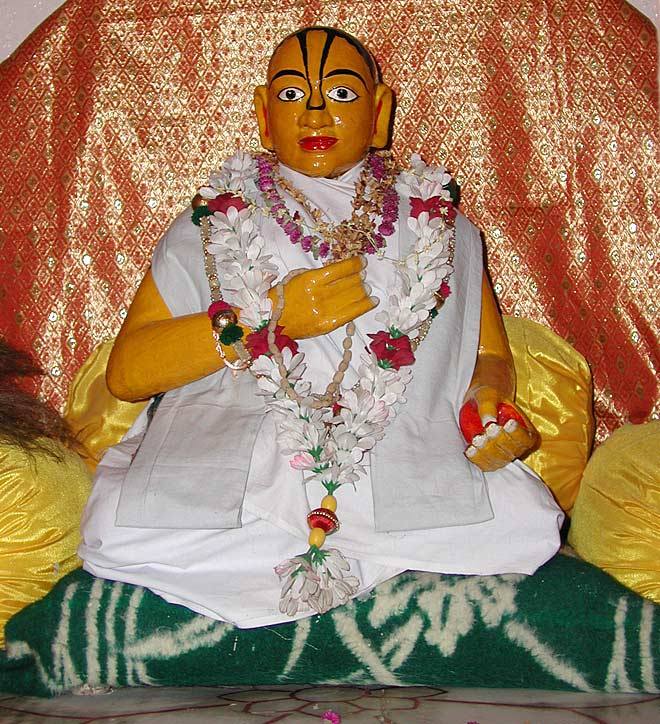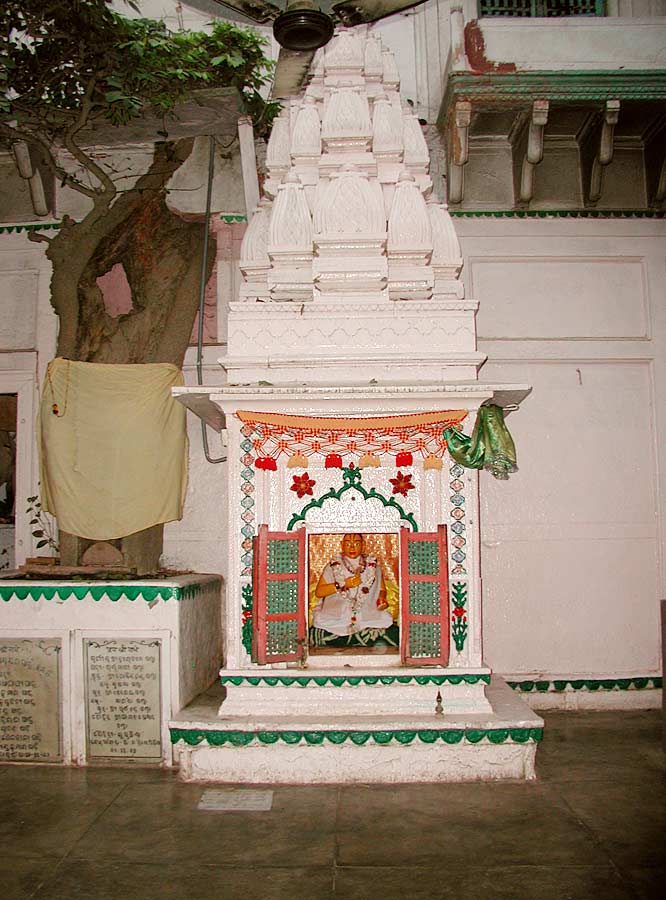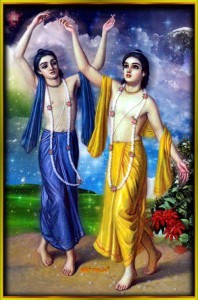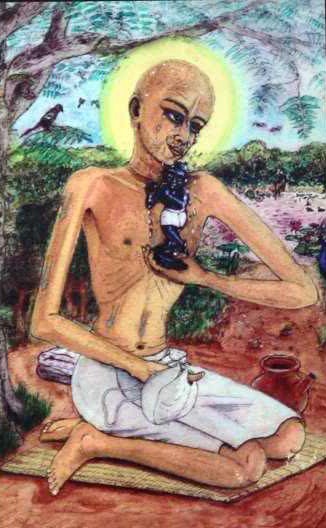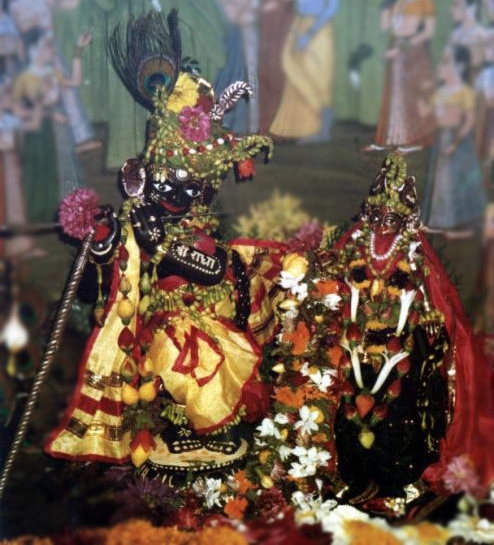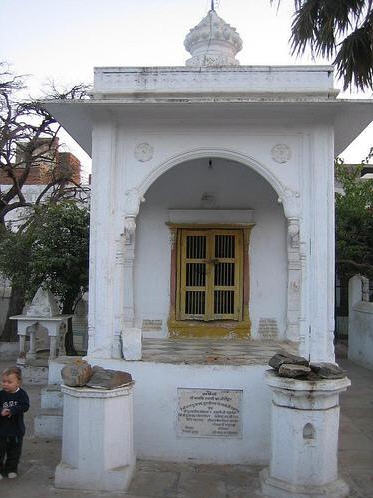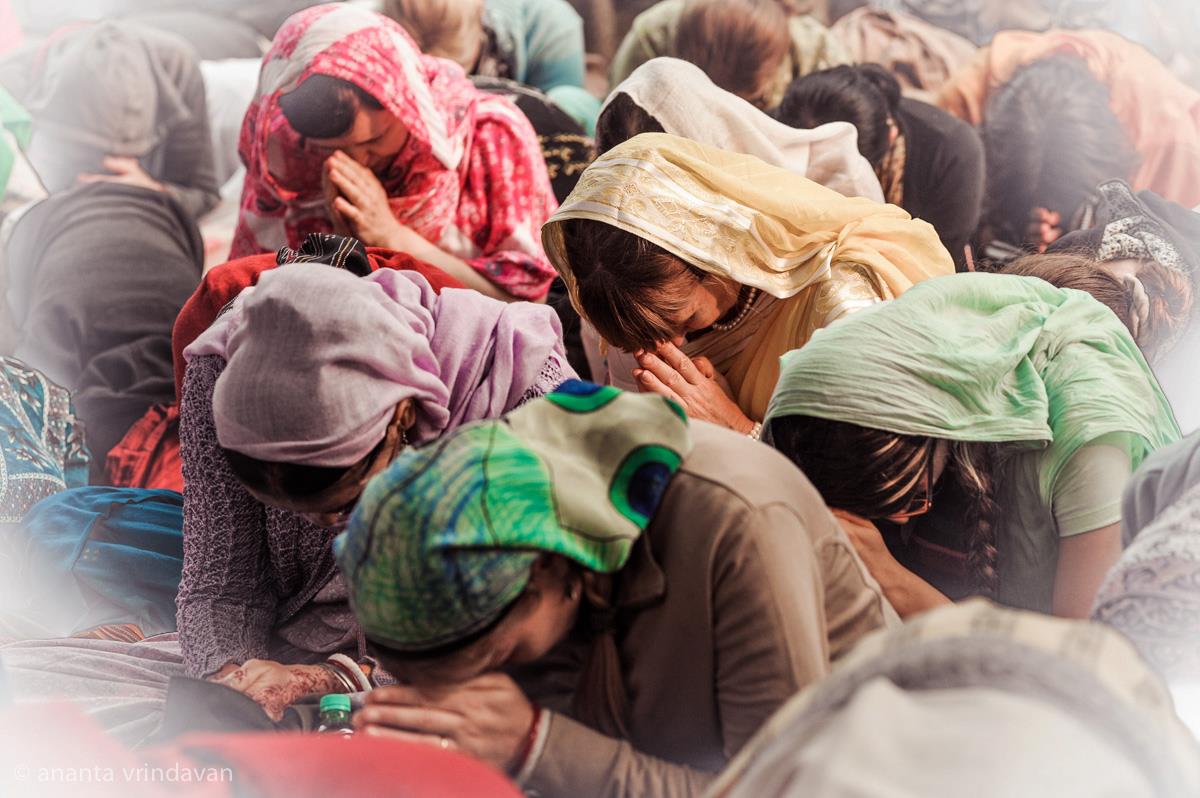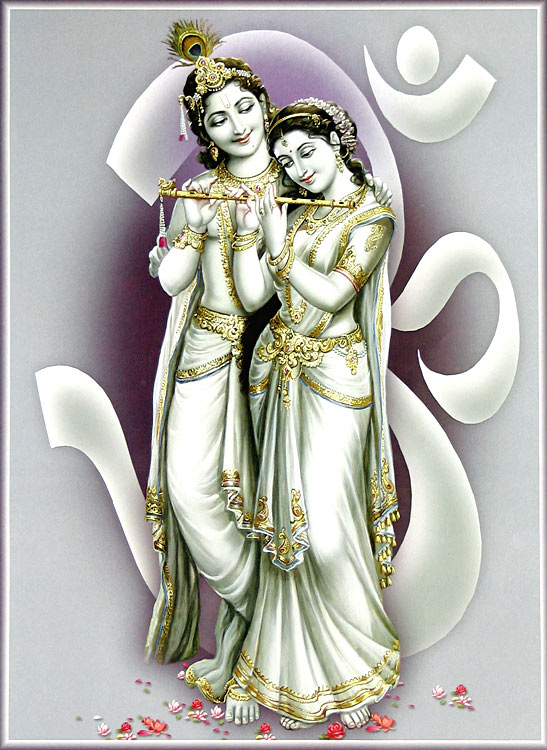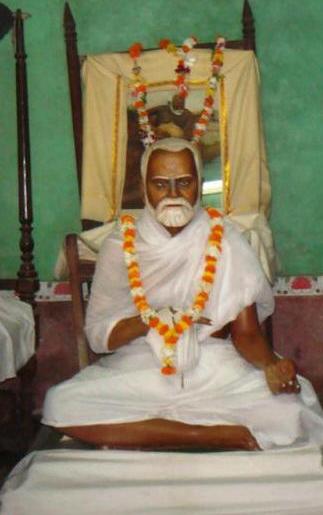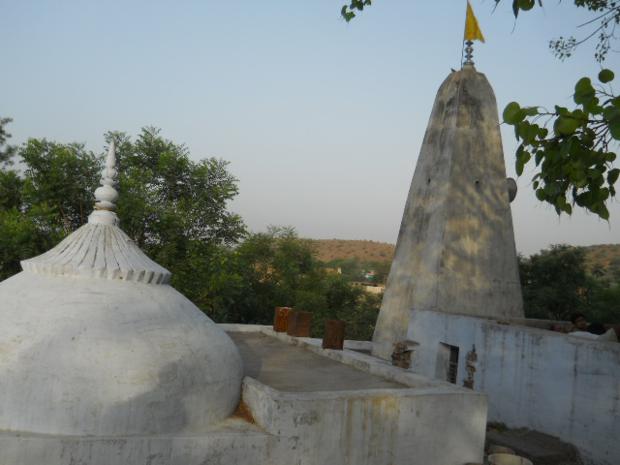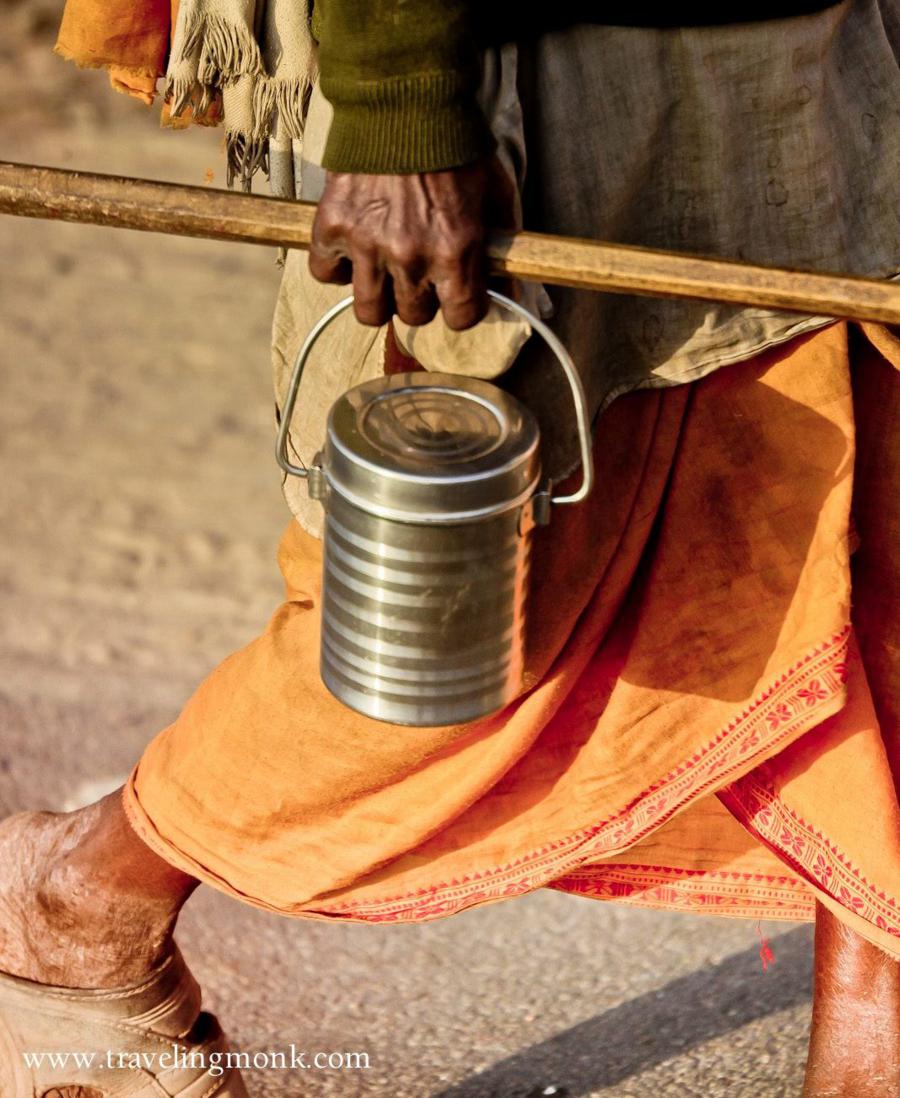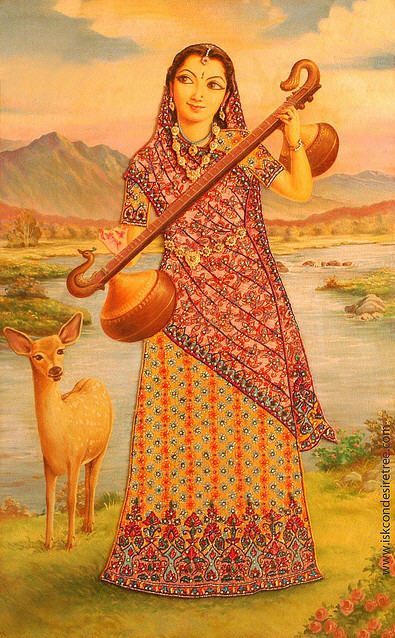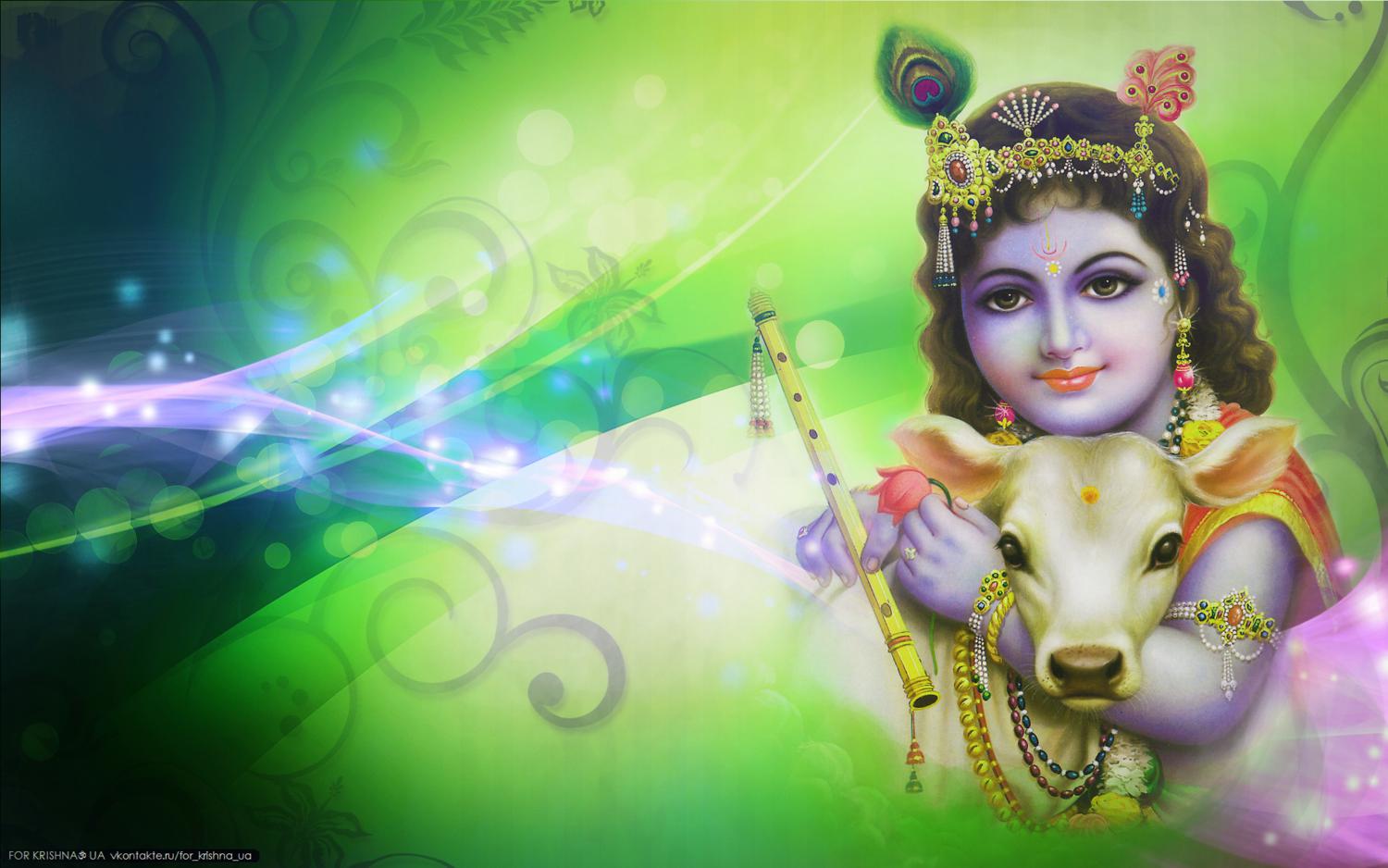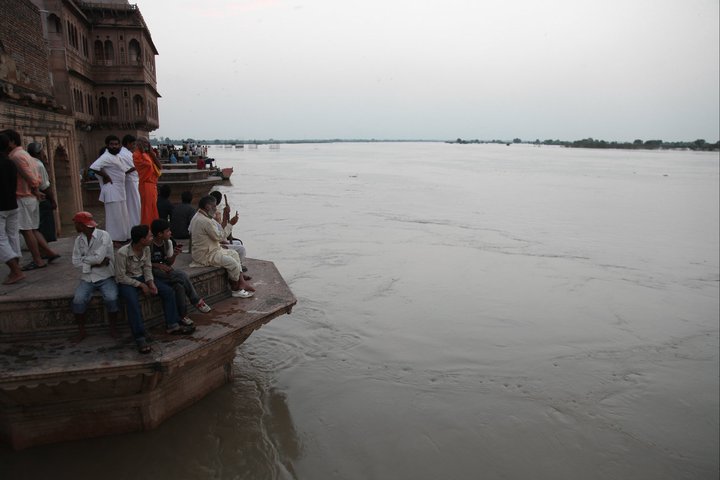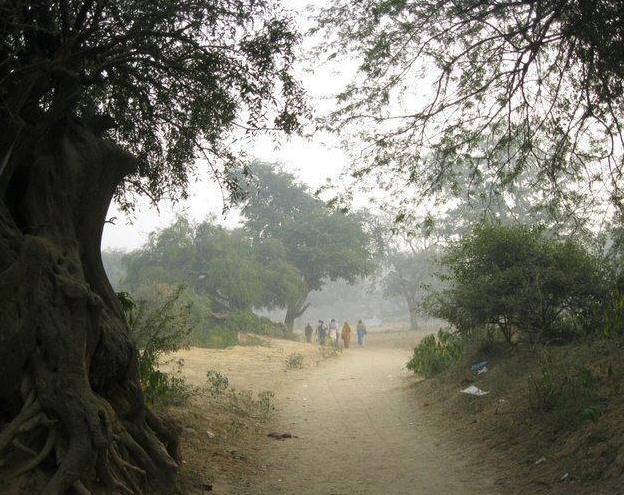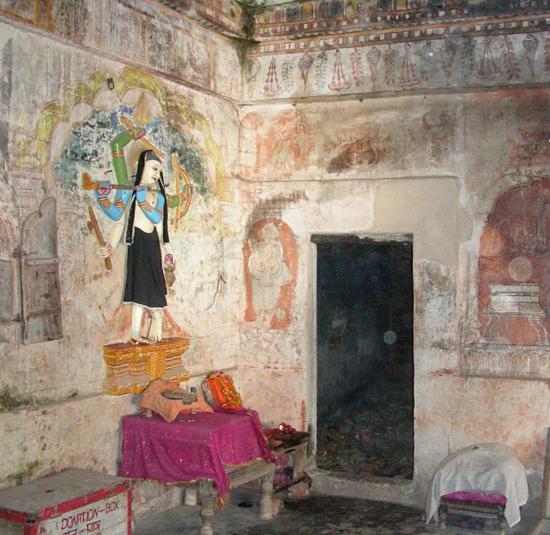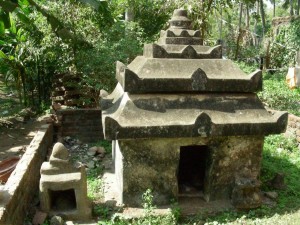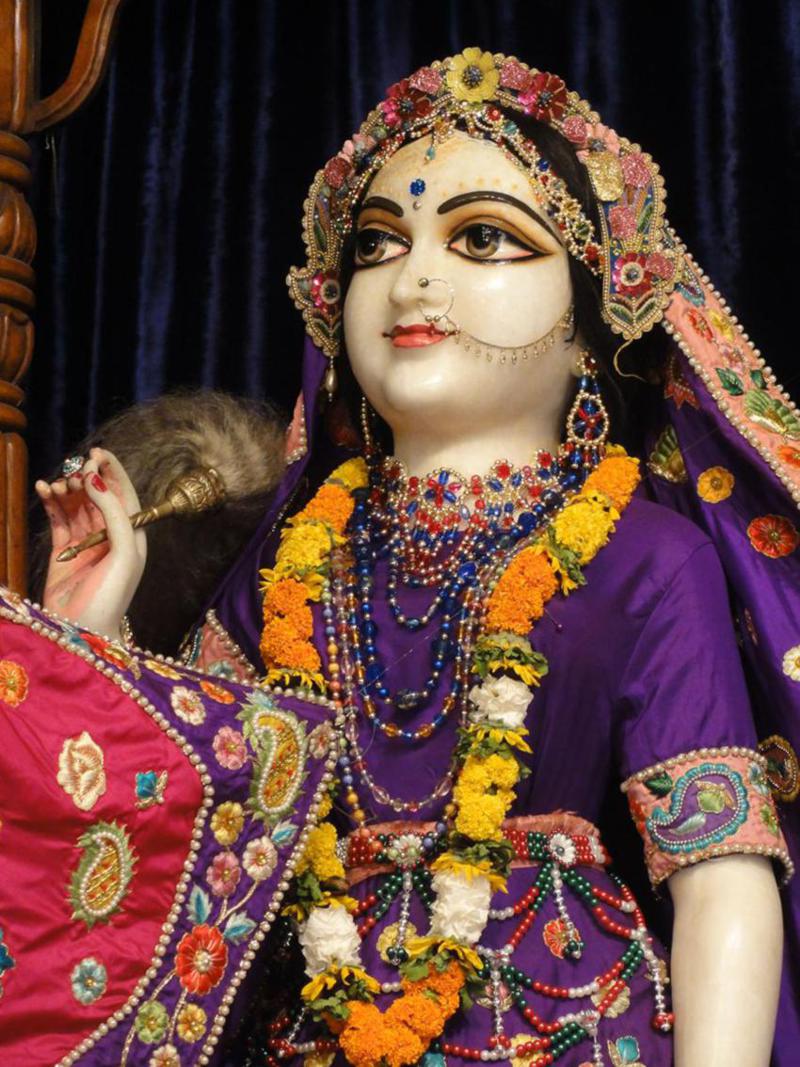
Shrila Bhaktivinoda Thakur writes, "The same love which Vishakha had for Radha and Krishna in Vraja, and that love which Radha and Krishna had for Vishakha, awakened in them when they met." Thus it is clear that Shrila Bhaktivinoda Thakur saw Ramananda Raya as Vishakha. (In the image: Shrimati Vishakha Devi, ISKCON Mayapur, India).
militva samabhud ramananda-rayah prabhoh priyah
ato radha-krishna-bhakti-prema-tattvadikam kriti
ramanando gauracandram pratyavarnayad anvaham
lalitety ahur eke yat tad eke nanumanyante
bhavanandam prati praha gauro yat tvam prithapatih
gopyarjuniyaya sardham ekibhuyapi pandavah
arjuno yad raya-ramananda ity ahur uttamah
arjuniyabhavat turnam arjuno ‘pi ca pandavah
iti padmottara-khande vyaktam eva virajate
tasmad etat trayam ramananda-raya-mahashayah
There are two Arjunas in Krishna lila: one is a priya-narma-sakha in Vraja, the other is one of the Pandavas. These two combined to become Ramananda Raya, the dear companion of Mahaprabhu. He was very knowledgeable in the teachings of loving devotion to Radha and Krishna, which he described to Gaurachandra on a daily basis. Some people say that Ramananda Raya was Lalita Sakhi, while others do not. Mahaprabhu Himself told Bhavananda Raya that he was Pandu, the husband of Kunti and father of the Pandavas. The Pandava Arjuna also united with the gopi named Arjuniya. Thus the most aware say that Ramananda Raya combined all these three personalities. Proof of this is found in the Padmapurana, where it is stated that the Pandava Arjuna became the gopi Arjuniya. (Gaura-ganoddesha-dipika 120-124)
As stated in these verses from Gaura-ganoddesha-dipika, some people hold that Ramananda Raya was an incarnation of Lalita. Some others are of the opinion that he was Vishakha. In his commentary on Chaitanya Charitamrita (2.8.23), Shrila Bhaktivinoda Thakur writes, "The same love which Vishakha had for Radha and Krishna in Vraja, and that love which Radha and Krishna had for Vishakha, awakened in them when they met." Thus it is clear that Shrila Bhaktivinoda Thakur saw Ramananda Raya as Vishakha.
Ramananda Raya was one of the Lord’s three and a half most intimate associates.
The Lord accepted Shikhi Mahiti’s sister as one of Radha’s friends. In the entire world, there were only three and a half Devotees who were so worthy. They were Svarupa Damodar Goswami, Ramananda Raya and Shikhi Mahiti. His sister was the half person. (Chaitanya Charitamrita 3.2.105-6)
Ramananda’s Social Status
Ramananda Raya’s father was named Bhavananda Raya. He was born in a family of the Orissan karana caste, an administrative clan like the kayasthas. He was previously King Pandu. He had five sons, of whom Ramananda was the oldest. The other four brothers were Gopinath Pattanayaka, Kalanidhi, Sudhanidhi and Vaninatha Pattanayaka. The Lord states in Chaitanya Charitamrita: "You are Pandu himself, and your wife is Kunti. Your five sons are the five Pandavas." (Chaitanya Charitamrita 2.10.53)
Bhavananda Raya made his home in Brahmagiri or Alalanath, about 12 miles west of Puri. Manohara Raya, a descendant of Ramananda Raya, has written his family’s history. Shrila Bhaktisiddhanta Saraswati Goswami Thakur has summarized some details of this account in his Anubhashya and concludes: "Orissan society considers the karana community to be part of the shudra caste. Ramananda Raya was born into this community. Nevertheless, though he was considered by society to be a shudra by birth, he was a de facto Brahmin, indeed, as a Vaishnava paramahamsa, he was spiritual master to the Brahmins."
By Krishna’s will, the creator Brahma himself appeared in an outcaste family in order to show that one’s family and one’s race have absolutely no importance. Born as a Muslim, Hari Das still enriched Lord Gauranga’s pastimes.

By Krishna’s will, the creator Brahma himself appeared in an outcaste family in order to show that one’s family and one’s race have absolutely no importance. Born as a Muslim, Hari Das still enriched Lord Gauranga’s pastimes. (In the wallpaper: Shrila Haridas Thakur, background image is Harinaam Sankirtan in Poland).
Hari Das Thakur was born in a low-caste family on the Lord’s order in order to show that caste and class have no importance at all. All the scriptures say that a Devotee of Vishnu, though born in a lowly family, is still worshipable by all. What will one’s caste do for one is born in a high-caste but does not worship Krishna? He will go to hell in spite of his high birth. Hari Das took a low birth just to bear witness to these scriptural statements. He is comparable to Prahlad who was born in a family of demons, or Hanuman, who was born a monkey. They belong only superficially to low castes. (Chaitanya Bhagavat 1.16.237-240)
A Vaishnava is beyond the qualities of the material nature. Anyone who considers a Devotee in terms of his birth or race is destined for a hellish existence.
arcye shiladhir gurushu naramatir vaishnave jatibuddhir
vishnor va vaishnavanam kalimalamathane padatirthe ‘mbubuddhih
shrivishnor namni mantre sakala-kalushahe shabda-samanya-buddhir
vishnau sarveshvareshe tad-itara-samadhir yasya va naraki sah
Anyone who considers the Deity to be nothing but stone,
The guru to be an ordinary human being,
Or the Vaishnava to be a member of a particular caste or race,
Who takes the holy water which has washed Vishnu or the Vaishnava’s feet
And can destroy all the sins of the age of kali,
To be ordinary water,
Who thinks that the name or mantra of Vishnu,
Which destroys all evils, is the same as any other sound,
Or who takes Vishnu to be same as anything other than Him,
Has a hellish nature.
(Padma-Purana)
According to the Bhajana-nirnaya, Ramananda was the disciple of Raghavendra Puri and grand-disciple of Madhavendra Puri.
Sarvabhauma Tells the Lord about Ramananda

Mental speculation is of no value for understanding the nature of the Supreme Lord. Without the Lord’s mercy, no person can come to know Him. One to whom the Lord gives even a slight drop of mercy is able to understand His nature. (Chaitanya Charitamrita 2.6.82-3) (In the image: Lord Vishnu on Garuda, suffering living entity).
Raya Ramananda was King Prataparudra’s governor in Vidyanagara and later was one of his ministers.
The Lord took sannyas in the month of Magh and arrived in Puri during the month of Phalgun. After celebrating the Dola Yatra in Puri, Mahaprabhu delivered Sarvabhauma Bhattacharya in the month of Chaitra. In the month of Vaishakh, He set off on His pilgrimage to South India. Though Mahaprabhu had decided to travel alone, Nityananda Prabhu convinced Him to take a servant, Krishna Das, as a travelling companion. As He was leaving, Sarvabhauma Bhattacharya gave the Lord four kaupinas and loincloths, and requested Him to visit Ramananda Raya on the banks of the Godavari.
As Lord Shri Chaitanya Mahaprabhu was departing, Sarvabhauma Bhattacharya submitted the following at His lotus feet, "My Lord, You must fulfill this request of mine. In the town of Vidyanagara, on the bank of the Godavari, there is a responsible government officer named Ramananda Raya. Please do not neglect him, thinking he belongs to a shudra family engaged in materialistic activities. Please take my word for it that You should meet him without fail. If anyone is fit to associate with You, it is he. No other Devotee can compare with him in knowledge of the divine sentiments. He has attained the highest limits of learning as well as being experienced in the science of devotional sentiments. If You converse with him, You will recognize his exalted character. When I first met him, I could not understand that everything he said and did were all transcendental. I made fun of him simply because he was a Vaishnava. By your mercy I can now understand the truth about Ramananda Raya. In talking with him, You also will acknowledge his greatness." (Chaitanya Charitamrita 2.7.61-67)
Shrila Prabhupada Bhaktisiddhanta Saraswati has commented as follows (2.7.63): "To superficial understanding, Ramananda Raya was not a sannyasi wearing a loincloth. In common understanding, those who are courtiers engaged in government service are materialistic, but Ramananda Raya was in fact a learned person who was a de facto sannyasi, as a perfected human being. Sarvabhauma Bhattacharya had previously been able to recognize his natural qualitie as a Vaishnava, even though he himself was not a Vaishnava at that time. When he took to devotional service by the grace of the Lord, he reconsidered his opinion of Ramananda and realized the extent of his qualifications, calling him an adhikari rasika-bhakta — the most highly qualified authority in the matters of devotional sentiment."
Sarvabhauma Bhattacharya was the incarnation of Brihaspati and the court pandita of King Prataparudra. He was so learned that even though a householder, he had sannyasis as his disciples. Nevertheless, he had been unable to recognize that Chaitanya Mahaprabhu was the Supreme Lord Himself, nor was he able to identify Ramananda Raya as His most intimate associate. If he was unable to do so, then how much more difficult it would be for others! No one is able to understand the glories of the Lord and His Devotees without being blessed by their mercy.
Mental speculation is of no value for understanding the nature of the Supreme Lord. Without the Lord’s mercy, no person can come to know Him. One to whom the Lord gives even a slight drop of mercy is able to understand His nature. (Chaitanya Charitamrita 2.6.82-3)
Mahaprabhu meets Ramananda
Mahaprabhu set off to the south, blessing the inhabitants of the land by bestowing devotion to Krishna on them. He visited Kurma-sthana, delivering the Brahmin also named Kurma, and giving everyone the order to preach devotional service to Krishna. He saved Vasudeva Vipra and then went on the Simhachalam where He danced before the Deity of Jiyari Nrisingha. Then He went on to the Godavari River, which in His vision was the Yamuna, and the woods on its banks, Vrindavan. He joyfully crossed the river and came to the place known as Kabhura, where He bathed in the river, hoping to meet Ramananda Raya. Coming out of the water, He sat down and waited for him.
At the same time, Ramananda Raya passed by with a fanfare. When he saw Mahaprabhu’s supernatural form, he descended from his palanquin and paid his obeisances to the Lord. Though Mahaprabhu recognized him, He asked him to identify himself. Ramananda replied that he was nothing but a lowly shudra servant. When the Lord heard him speak in this humble manner, He immediately embraced him. Both the Lord and His servant felt the onset of divine emotions and the both experienced the eight ecstatic transformations of prema. The Brahmins who were accompanying Ramananda were astonished to see such a display. They thought,
"This sannyasi is as effulgent as the brahmajyoti. Why is He crying while embracing this shudra? The governor Ramananda is a scholar and normally very serious. Why has become so emotional upon being touched by this sannyasi, as though intoxicated?" (Chaitanya Charitamrita 2.8.26-7)
Seeing that there were outsiders present, the Lord controlled His emotions and told Ramananda that He had been told by Sarvabhauma Bhattacharya to seek him out. Ramananda replied with humility,
This is the proof of Your mercy to Sarvabhauma Bhattacharya: You have touched me, an untouchable, simply due to his love for You. What a difference exists between us — You are the Supreme Lord, Narayan Nimself, and I, a government servant interested in materialistic activities. Indeed, I am the lowest amongst men of the fourth caste. Even so, You were not contemptuous of my touch, neither did You fear the Vedic injunctions which forbid one to even look upon a shudra. Your mercy makes You touch me, even though this activity is condemned by scripture and by society. Who can understand Your intention, for You are the Supreme Lord Himself. (Chaitanya Charitamrita 2.8.34-7)

He went on to the Godavari River,...hoping to meet Ramananda Raya. Coming out of the water, He sat down and waited for him...At the same time, Ramananda Raya passed by with a fanfare. When he saw Mahaprabhu’s supernatural form, he descended from his palanquin and paid his obeisances to the Lord. Though Mahaprabhu recognized him, He asked him to identify himself. Ramananda replied that he was nothing but a lowly shudra servant. When the Lord heard him speak in this humble manner, He immediately embraced him. Both the Lord and His servant felt the onset of divine emotions and the both experienced the eight ecstatic transformations of prema. The Brahmins who were accompanying Ramananda were astonished to see such a display. They thought, "This sannyasi is as effulgent as the brahmajyoti. Why is He crying while embracing this shudra? The governor Ramananda is a scholar and normally very serious. Why has become so emotional upon being touched by this sannyasi, as though intoxicated?" (Chaitanya Charitamrita 2.8.26-7) (In the wallpaper: Shri Gauranga Mahaprabhu, Ramananda Raya, local brahmanas, background image of the Godavari river).
Though the Brahmins had never shown the slightest interest in bhakti, they too were influenced by the sight of the Lord and began to chant the names of Krishna, their voices tremulous with divine ecstasy. Ramananda Raya said aloud that Mahaprabhu was the Supreme Lord, both in akriti, or form, and in prakriti, or nature. The Lord immediately responded in a way that would show the greatness of His Devotee:
The Lord said, "You are a great Devotee, indeed you are the best amongst them. All those who behold you are immediately affected so that their hearts melt. What to speak of others — I am a mayavadi sannyasi, yet I feel the onset of Krishna prema when I touch you." (Chaitanya Charitamrita 2.8.44-5)
The Lord Listens to Ramananda Speak
When Mahaprabhu told him of His desire to hear Krishna-katha from his lips, Ramananda suggested that He stay for a week or so at his house so that his own wicked mind could be pacified and purified. The two then each went their way to finish their duties, returning to the same spot in the evening. Ordinarily, it is seen that a Devotee asks the questions and the Lord answers. This time, however, the roles were reversed and the Lord asked Ramananda to clarify certain spiritual truths and then empowered him to respond. Krishnadas Kaviraj Goswami makes this explicit in the verse which opens the eighth chapter of the Madhya-lila:
sancarya ramabhidha-bhakta-meghe
svabhakti-siddhanta-cayamritani
gaurabdhir etair amuna vitirnais
taj-jnatva-ratnalayatam prayati
Gauranga is like the ocean of spiritual truths; He filled the cloud named Ramananda with the nectar of the purest conclusions of devotion to Himself. Ramananda then rained down that same nectar on the very ocean from which it had come, producing the jewels of transcendental knowledge. (Chaitanya Charitamrita 2.8.1)
A person who has not taken shelter of the Lord may try to understand the Supreme Truth by using empirical means, without achieving any success. Indeed, he will fall into confusion and be unable to understand the words of the Lord.
Mahaprabhu asked Ramananda Raya to explain to him, with evidence from the scriptures, the ultimate goal of life. Ramananda started his response by explaining that devotion to Vishnu was the ultimate aim of human achievement, or sadhya. In this theistic conception, he described progressive path of different practices leading to that goal, starting from the practice of varnashrama dharma, offering the fruits of one’s activities to Krishna (karmarpana), renunciation of prescribed duties (karma-tyaga ) and devotion mixed with knowledge (jnana-mishra-bhakti ), offering the scriptural basis for each step. Mahaprabhu rejected each proposal, however, saying that it was superficial or external, for none of these practices were potential means for achieving the pure devotion which He had come to give.
By starting this conversation with Ramananda Raya with varnashrama dharma , Mahaprabhu showed that all activities which ignore the Vedic principles or go against them are to be completely rejected. When responding to each of Ramananda’s suggestings, Mahaprabhu did not say, "Absolutely not!", He rather used the words, eho bahya, "This too is peripheral." The idea is that one must first give up activities which are outside the scope of the Vedic standard. Once one is fixed in these principles, one can progressively gain the qualifications to proceed through each of the various steps described by Ramananda. This holds true even though bhakti itself is completely independent and may manifest in an individual through the association of saintly persons despite one’s having no prior qualifications or having gone through these prior steps.
When Ramananda Raya finally answered Mahaprabhu’s question by saying "Pure devotional service without any tinge of speculative knowledge (jnana-shunya-bhakti ) is the means to achieve the supreme perfection.", Mahaprabhu finally accepted his conclusion. From this point on, Mahaprabhu’s teachings actually begin. The words jnana-shunya are meant to completely eradicate any consciousness of the impersonal aspect of the supreme, and not the kind of knowledge of relationships (sambandha-jnana) which is favorable to the attainment of pure devotional service.
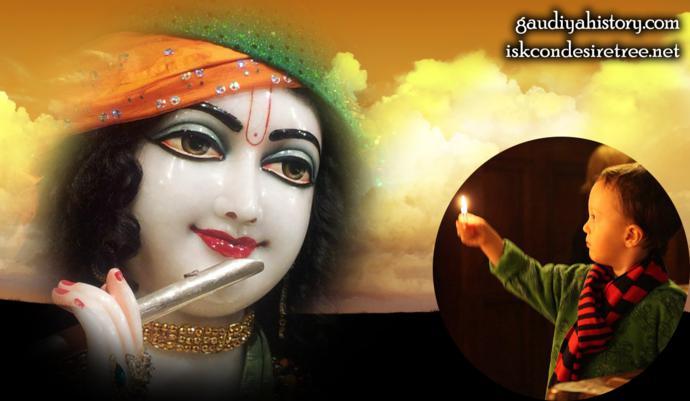
"Pure devotional service without any tinge of speculative knowledge (jnana-shunya-bhakti ) is the means to achieve the supreme perfection." (In the wallpaper: Shri Krishna, ISKCON Chennai, a Devotee boy).
Shrila Bhaktivinoda Thakur writes in his Amrita-pravaha-bhashya, "The purport is that sacrificing the results of one’s actions is better than merely engaging in one’s prescribed duties according to the varnashrama dharma ; the renunciation of fruitive activities is better than simply giving up the fruits; better than this is the cultivation of knowledge mixed with devotional service. However, despite this progressive improvement in spirituality through these stages, they are all superficial because these four kinds of practices have no power to achieve pure devotion, or shuddha bhakti. The devotion known as aropa-siddha , by which is meant adding a devotional veneer as an afterthought, or sanga-siddha, by which is meant devotion by associating a fruitive activity with some devotional act, are never to be considered pure devotional service. Pure devotional service is Svarupa-siddha bhakti, i.e., it is devotion both in form and in intent. It is entirely different from these other activities which have only a superficial relationship to devotional service. The characteristics of shuddha bhakti are that it is activity executed uniquely for the pleasure of Krishna, devoid of any material desires, it is not hidden by the presence of fruitive intent or knowledge of brahman. This is the consciousness that is the ultimate goal of spiritual practice, for though it is practiced by an aspiring Devotee, it is realized when he reaches perfection of his practice." (2.8.68)
As long as Ramananda Raya suggested anything other than following in the footsteps of the great Devotees and listening to Krishna-katha from his lips, Mahaprabhu kept saying, "This is irrelevant." Therefore it is to be understood that pure devotion starts from the moment one begins to hear about the activities and teachings of Lord Krishna from the lips of a pure Devotee. From this point, Ramananda Raya described the various stages of pure devotion, the moods of neutrality, servitude, friendship, parenthood and conjugal love. From there, he went on to describe Radha’s love as being supreme as well as both Radha and Krishna’s characteristics. Then Mahaprabhu asked questions like "What is the essence of education?", "What kind of fame is best for the living being?". All these things have been extensively described in the eighth chapter of Chaitanya Charitamrita’s Madhya-lila. In order to avoid deviating too much from the account of Ramananda’s life, we will not go into these matters any further here.
Ramananda’s Perception of the Lord’s Identity
The identity of the Lord cannot remain hidden to His Devotee. Ramananda was able to recognize the Lord for who He was. He said,
"First I saw You as an ordinary sannyasi. Now I see that You are actually a dark-skinned cowherd boy. I see a golden puppet standing in front of You; its golden effulgence covers Your entire body." (Chaitanya Charitamrita 2.8.268-9)
Mahaprabhu made an effort to dissimulate His identity when He heard this, saying that Raya Ramananda was a great Devotee and thus saw Krishna everywhere. Ramananda, however, clearly stated the primary purpose of the Lord’s incarnation. Mahaprabhu was pleased with his insightful realization and He displayed His form as the combination of rasa-raja ("the king of the devotional sentiments") Krishna and the incarnation of maha-bhava ("the supreme devotional mood"), Shrimati Radharani. When he saw this amazing combined form of the Lord, Ramananda Raya fell to the ground in a faint. When the Lord touched him, he regained consciousness.
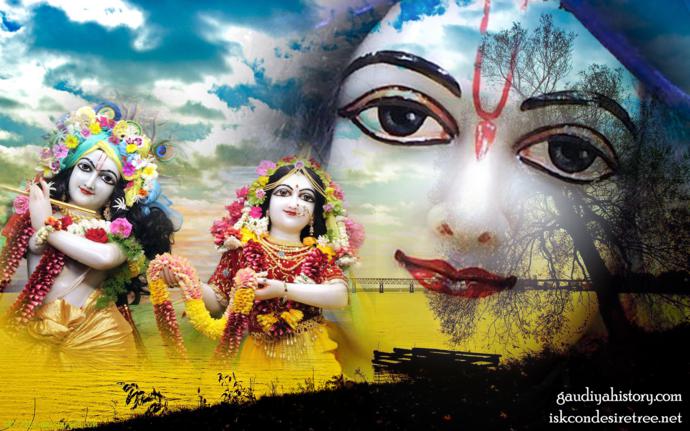
"First I saw You as an ordinary sannyasi. Now I see that You are actually a dark-skinned cowherd boy. I see a golden puppet standing in front of You; its golden effulgence covers Your entire body." (Chaitanya Charitamrita 2.8.268-9)...Mahaprabhu was pleased with his insightful realization and He displayed His form as the combination of rasa-raja ("the king of the devotional sentiments") Krishna and the incarnation of maha-bhava ("the supreme devotional mood"), Shrimati Radharani. When he saw this amazing combined form of the Lord, Ramananda Raya fell to the ground in a faint. When the Lord touched him, he regained consciousness. (In the wallpaper: Shri Shri Radha Gopinath, Shri Gaurachandra, ISKCON Chowpatty, Mumbai).
They remained together for ten days, enjoying discussions of Krishna conscious topics. Before Mahaprabhu continued on His southern pilgrimage, He asked Ramananda to abandon his involvement with government service and join Him in Puri when He returned.
When Mahaprabhu completed His sojourn in southern India, He met with Ramananda once again on the banks of the Godavari. He showed him the two books, Krishna-karnamrita and Brahma-samhita, which He had found in His travels, and which substantiated all that Ramananda Raya had said in their previous conversations. Ramananda Raya copied the two manuscripts himself. The Lord remained another week with Ramananda, enjoying the pleasure of discussions about Krishna before heading back to Nilachala. Ramanada refused to go with the Lord immediately as he was obliged to wait for the King’s permission and also would need to take care of his personal affairs. He promised to join the Lord in Puri as soon as he was able.
Ramananda Comes to Puri
When the Lord arrived in Puri, He made His permanent residence in the house of Kashi Mishra. King Prataparudra had heard about the Lord and was very enthusiastic about meeting Him. Sarvabhauma Bhattacharya had assured him that once the Lord had returned from His southern pilgrimage, He would somehow or other arrange for Him to have darshan. Unfortunately, no matter how hard Sarvabhauma Bhattacharya tried to convince Him, the Lord insisted that He would not look upon a king. Thus all attempts to arrange a meeting met with failure.
When the King heard that Ramananda wished to return to Puri in order to be close to Mahaprabhu, he was quite happy to grant him permission. He allowed him to leave his duties in the government and continued to pay him a pension. Thus Ramananda first met with the King in Chuttack, and then in Puri, before going to Kashi Mishra’s home to meet with the Lord Himself. Ramananda knew just how eager the King was to encounter Mahaprabhu, but rather than bringing up the matter directly, he simply glorified the king, telling Mahaprabhu how much faith he had in the Him, how deep was his devotion to Krishna, and how kind he had been to free Ramananda from his governmental duties so that he could serve the Lord directly. By recounting the King’s virtues in this way, he was able to melt the Lord’s resolve.
In the meantime, Nityananda Prabhu had sent one of the Lord’s loincloths to King Prataparudra as a consolation. Though this gave the King a great deal of joy, his desire to meet the Lord simply increased and he asked Ramananda to intercede on his behalf and make some kind of arrangement. When Ramananda finally approached the Lord directly, asking Him to be compassionate toward the King, the Lord was not able to refuse him directly. He agreed that the King was no ordinary materialistic person, but nevertheless, the very title raja was a type of contamination that He could not overlook. So He agreed to allow the king’s son to come and see Him, as the son and father are, in a sense, one.
Mahaprabhu said, "There may be much milk in a big pot, but if it is contaminated by a drop of liquor, it is untouchable. The King certainly possesses all good qualities, but everything has been ruined simply by his possesion of the kingly title. If you are still very eager for the King to meet with Me, then you can bring his son in his place. The scripture states that one’s self is reborn in the son, therefore if his son comes, it will be equal to his meeting with Me." Ramananda Raya then went to inform the King about his talks with the Lord, and, according to his request, brought the King's son to see Him. (Chaitanya Charitamrita 2.12.53-7)
Appreciating Rupa’s Plays
Rupa Manjari is the follower of the sakhis Lalita and Vishakha, who are not different from Ramananda Raya. Rupa Goswami discussed the subject of his two plays, Lalita-madhava and Vidagdha-madhava with Ramananda. When Ramananda asked to hear a verse about the play’s
anarpita-carim cirat karunayavatirnah kalau
samarpayitum unnatojjvala-rasam sva-bhakti-shriyam
harih purata-sundara-dyuti-kadamba-sandipitah
sada hridaya-kandare sphuratu vah shacinandanah
The elevated, effulgent taste of sacred rapture
Is the wealth of devotional love;
The Lord never gives it at any time;
Yet, out of His mercy in this age of quarrel,
To distribute this treasure to the world,
He has become incarnate in His golden form.
The son of Sachi is like a lion;
May He dwell in the cave of your heart forever.
When Ramananda Raya heard this verse, he began to praise Rupa Goswami with what seemed like a thousand tongues. He said that Rupa could only have written such an accurate portrayal of such difficult concepts as a result of the Lord’s mercy.
Pradyumna Mishra Meets Ramananda
In order to reveal the extent of His transcendental character and identity, Mahaprabhu sent Pradyumna Mishra, who was born in an upper-class Brahmin family to Ramananda to be instructed, even though Ramananda was not of such high caste. Pradyumna Mishra was born in Sylhet, but later made his permanent home in Orissa. He came one day to Mahaprabhu asking to hear some Hari-katha. Mahaprabhu replied with great humility that He was not qualified to speak on elevated matters of sacred rapture, and sent him to meet Ramananda Raya.
At that time, Ramananda Raya was in the Jagannath-vallabha gardens, engaged in preparing two young deva-dasis for a play which was to be given before Lord Jagannath. Not only was he training them in the songs that they would sing and in the dance they would perform, but also bathing, dressing and decorating them. The first time that Pradyumna Mishra came to see Ramananda, one of Ramananda’s servants told him that he was busy doing this work and asked Mishra to sit outside and wait. None of Ramananda Raya’s servants dared to interrupt him while he was busy preparing the performance which was to be given before Lord Jagannath. Only after he had finished the rehearsal and come outside did he learn that Pradyumna Mishra had come there to hear about Krishna from him.
Ramananda showed the Brahmin the appropriate respect and begged forgiveness for the long delay. Mishra realized that it was too late that day for his wish to be fulfilled and he returned home. Some days later, when Mahaprabhu saw Mishra, he asked him how the meeting with Ramananda had gone and what topics they had discussed. Pradyumna Mishra told him everything that had happened and told the Lord that some doubts had risen in his mind about Ramananda’s activities. The Lord immediately took steps to erase these doubts from the Brahmin’s mind. He began to glorify Ramananda’s extraordinary character with great force. He said:
"I am a sannyasi and I consider Myself to be renounced. But if I even hear the name of a woman, what to speak of seeing one, I feel an effect on My mind and body. So who is not moved by the sight of a woman? Everyone listen to Me. Let Me tell you about Ramananda Raya, although they are so wonderful and uncommon that they really cannot be properly described. He personally serves Jagannath’s young and beautiful devadasis in every possible way. He personally bathes and dresses them and decorates them with ornaments. While doing so, he naturally sees and touches the private parts of their bodies, but even so, his mind is never affected. He teaches the girls how to physically express all the moods of love, to be acted out before Jagannath Deva, but his mind and body are as steady as wood or stone. Indeed, it is amazing that even when he touches such young girls, his mind is not disturbed. Only Ramananda has the right to do such things, and seeing him do them, I can understand that his body is not material but has been completely transformed into a spiritual entity." (Chaitanya Charitamrita 2.5.35-42)
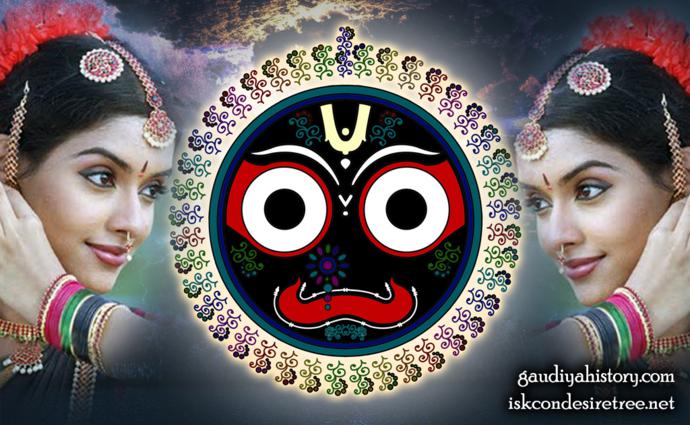
"...He personally serves Jagannath’s young and beautiful devadasis in every possible way. He personally bathes and dresses them and decorates them with ornaments. While doing so, he naturally sees and touches the private parts of their bodies, but even so, his mind is never affected. He teaches the girls how to physically express all the moods of love, to be acted out before Jagannath Deva, but his mind and body are as steady as wood or stone. Indeed, it is amazing that even when he touches such young girls, his mind is not disturbed. Only Ramananda has the right to do such things, and seeing him do them, I can understand that his body is not material but has been completely transformed into a spiritual entity." (Chaitanya Charitamrita 2.5.35-42) (In the wallpaper: Lord Jagannath, the devadasi).
Mahaprabhu thus revealed Ramananda’s amazing powers to Pradyumna Mishra, and through him, to the world. He told Pradyumna that He Himself went to Ramananda to hear about Krishna, and He advised him to go a second time. This time, Pradyumna was able to hear Ramananda speak about Krishna in such depth and with such insight that he was astonished, so astonished in fact, that he began to dance in ecstasy.
Bhaktivinoda Thakur has written the following comment on the above pastime: "Raya Ramananda had composed a play which is known as Jagannath-vallabha-nataka . This play was performed in the Jagannath Temple for the pleasure of Jagannath Himself. The deva-dasis, or "virgins of the God", were girls who were given to the Deity as His wives and they were trained up in performing just for the Deity. In Orissan, they are now called maharis. Ramananda engaged two of these girls to play in his drama, directing them in how to play the emotions appropriate to the gopis. Since the two deva-dasis were playing the roles of chief gopis, Ramananda made no distinction between them and Krishna’s beloved mistresses. He considered himself to be their maidservant, and in that spiritual identity, engaged in their service by teaching them to dance and sing for their Lord. Because Ramananda Raya knew himself to be one of Shrimati Radharani’s handmaidens, he was able to project the identity of his worshipable mistress on the two deva-dasis and this is why he was able to serve them in this most intimate fashion without experiencing the disturbance of mundane sexual desire." (Amrita-pravaha-bhashya, 3.5.20)
Though a householder, Ramananda is not under the control of the six deadly sins (lust, anger, greed, illusion, intoxication and envy). Though a so-called materialistic person, he is qualified to instruct those in the renounced order of life. The Lord wished to reveal these qualities of Ramananda, and so He sent Pradyumna Mishra to listen to him speak about Krishna. The Lord knows very well how to make His Devotees virtues public. He considers it to be to His personal profit to do so by using various stratagems. O Devotees, listen carefully to yet another of the Lord’s characteristics: He manifests His own majestic nature, though these are usually hidden. He spreads real religious principles through a man from a lowly shudra in order to vanquish the false pride of so-called renunciants and learned scholars. He preached about devotional service, ecstatic love and the Absolute Truth by making Ramananda Raya, a grihastha born in a low family, the speaker, while He Himself, an exalted Brahmin-sannyasi, and Pradyumna Mishra, a pure Brahmin, both listened and took lessons from him. (Chaitanya Charitamrita 3.5.80-85)
Shrila Bhaktisiddhanta Saraswati Goswami Thakur comments on these words from the Chaitanya Charitamrita as follows: "To materialistic vision, Ramananda Raya is a grihastha on the pravritti-marga, engaged in an active life in the world. He is not, it is clear, a self-controlled brahmachari, vanaprastha, or sannyasi. A materialistic householder is under the control of his senses and this is the basis of his involvement in worldly activities. A Vaishnava householder who has attained the transcendental state, however, is not at all on the same level, transcending the influences of the six deadly sins and standing aloof from the influence of the senses. Ramananda Raya accepted the householder state as his role in the pastimes of Shri Chaitanya Mahaprabhu. Ordinary materialistic persons look upon him through glass that is tinted by their own desire for sense gratification and see him as one of their own, but in fact his mind had been totally spiritualized through being fixed on the supreme worshipable object. He was thus a Krishna-vishayi, one who seeks only the pleasure of Krishna’s senses and not his own. He was not an impersonalist or argumentative nihilist opposed to the Lord’s transcendental activities. Indeed, he possessed the power to transform the minds of such sannyasis who had abandoned sense gratification and were absorbed in the qualityless brahman without any appreciation for Krishna’s form and pastimes, and turn them away from their fundamentally materialistic conception of transcendence, attracting them to the practice of devotional service through hearing and chanting about Krishna’s name, form and activities."
Other Activities in Puri
When Vallabha Bhatta came to Puri and came into contact with Chaitanya Mahaprabhu, the Lord kept His own glories hidden from him because He knew him to be proud of his learning. He thus preferred to speak to Vallabha Bhatta about the qualifications of His entourage. At that time He said of Ramananda that he was expert both in the sambandha, or knowledge of the relationships between God, man and the universe, and the prayojana-tattva , or knowledge of life in the state of divine perfection. Furthermore, He indicated that he was the greatest connoisseur of the pure and sacred raptures of Vrindavan.
Ramananda Raya is the treasure house of divine sentiments. It was he who disclosed to Me that Krishna is the Supreme Personality of Godhead. No one can fully describe the extent of Ramananda’s spiritual power. Through him I was able to learn about the pure moods of the Devotees of Vraja. (Chaitanya Charitamrita 3.7.23, 37)
Ramananda Raya had the same type of relationship with Mahaprabhu that Subala, Krishna’s friend and helper used to have in Vraja. (Chaitanya Charitamrita 3.6.9)
Ramananda Raya was also present in Nilachala when Hari Das Thakur passed away. Mahaprabhu praised Hari Das before the Devotees led by Ramananda and Sarvabhauma Bhattacharya. (3.11.50)
Ramananda in the Lord’s Last Days
When the Lord was in His condition of divine ecstatic madness, He would sometimes disappear from His chambers, even though there were three barred doors through which He had to pass in order to go outside. Once He was found near the Lion’s Gate, His joints loosened and taking on a giant, distended form. He was be revived and returned to normal by loud singing of the Holy Names. On another occasion, He was found in the sand dunes which He had taken in His state of trance to be Govardhana. Once again, He was be pacified by sankirtan and returned to His home. On these occasions, Ramananda Raya was present with Svarupa Damodar. Throughout the ten transformations of the Lord’s ecstatic madness (divyonmada) , Ramananda Raya would recite verses which were fit the Lord’s emotional state. In this way, he brought pleasure to the Lord.
Mahaprabhu remained in Nilachala in this way, passing the days and nights absorbed in the anxiety of separation from Krishna. Svarupa and Ramananda were always with Him, bringing Him ecstasy with their recitation of songs and verses appropriate to His mood. (Chaitanya Charitamrita 3.20.3-4)
… the Lord took Svarupa Damodar and Ramananda Raya by the shoulders and said, "Listen, Svarupa and Rama Raya! Tell me what I should do, where should I go in order to find Krishna. You can tell Me the best thing to do." In this way, Gauranga would tell His tale of woe to Svarupa and Ramananda and they would console Him in His grief. Svarupa would sing and Ramananda would recite Sanskrit verses, giving joy to the Lord with verses from Krishna Karnamrita, the songs of Vidyapati and Gita-Govinda. (Chaitanya Charitamrita 3.15.24-7)
Remaining in the company of Svarupa and Ramananda both day and night, Mahaprabhu ecstatically relished the songs of Chandi Das, Vidyapati and Ramananda Raya’s plays, as well as Krishna-Karnamrita and Gita-Govinda. (Chaitanya Charitamrita 2.2.77)
Ramananda Raya performed his bhajana in the Jagannath-vallabha gardens, a place which was very dear to Mahaprabhu also. As soon as the Lord entered within this garden, He would be overwhelmed by feelings of divine love. One day, while the Lord was there, He had a vision of Krishna under an ashoka tree. Then, the vision was suddenly lost to Him, and Mahaprabhu fell to the ground in a faint.
The main park in Puri is the Jagannath-vallabha garden. The Lord entered there with His Devotees. The trees and flower bushes were in bloom, and it seemed as though it was Vrindavan. The parrots, mynah birds, and cuckoos were singing their songs and the bees were all buzzing. (Chaitanya Charitamrita 3.19.79-80)
Wandering through the garden, He went from tree to tree. When He came to an ashoka tree, He suddenly saw Krishna standing there. The Lord started to run towards Him, but Krishna laughed at Him and disappeared. The Lord was stunned: He had found Krishna and then had lost Him again. He lost consciousness and feel to the ground. (Chaitanya Charitamrita Antya 19.85-87)
Through Ramananda Raya and Shri Svarupa Damodar Goswami, Lord Chaitanya Mahaprabhu joyfully announced to the world that Harinama-sankirtan is the best means to attain love of God in this age of quarrel.
The Lord, in a wave of jubilation say, "Listen Svarupa Damodar and Ramananda Raya! In the age of Kali, Harinama sankirtan is the supreme means of deliverance. In the age of Kali, Krishna is to be worshiped by the congregational chanting of His Holy Names. This is the way that an intelligent person attains the lotus feet of Krishna. Through the chanting of the Holy Name, all of one’s sinful reactions are extinguished and all auspiciousness arises until finally one experiences the joys of love for Krishna." (Chaitanya Charitamrita 3.20.8-11)
There are two opinions about Ramananda Raya’s disappearance day: some people say Jyestha Krishna-panchami, others Vaishakhi Krishna-panchami.
[Excerpted from “Shri Chaitanya: His Life & Associates” by Shrila Bhakti Ballabh Tirtha Maharaj]
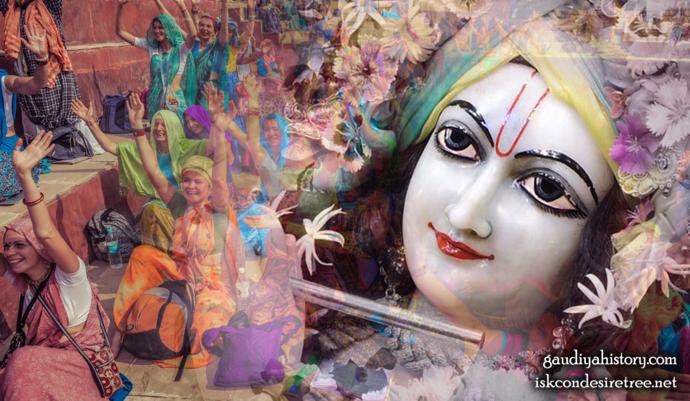
"Listen Svarupa Damodar and Ramananda Raya! In the age of Kali, Harinama sankirtan is the supreme means of deliverance. In the age of Kali, Krishna is to be worshiped by the congregational chanting of His Holy Names. This is the way that an intelligent person attains the lotus feet of Krishna. Through the chanting of the Holy Name, all of one’s sinful reactions are extinguished and all auspiciousness arises until finally one experiences the joys of love for Krishna." (Chaitanya Charitamrita 3.20.8-11) (In the wallpaper: Shri Gopinath, ISKCON Chowpatty, Mumbai, Devotees from Europe in Prem Sarovar, Shri Vrindavan Dham).








